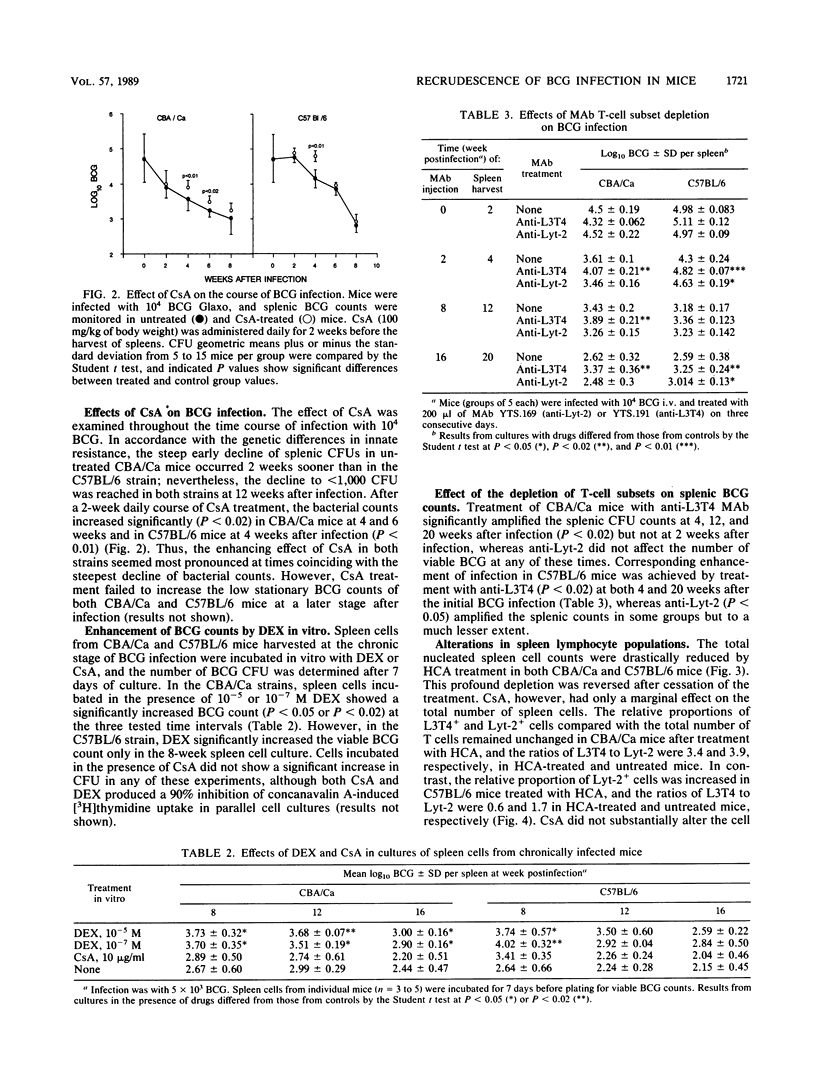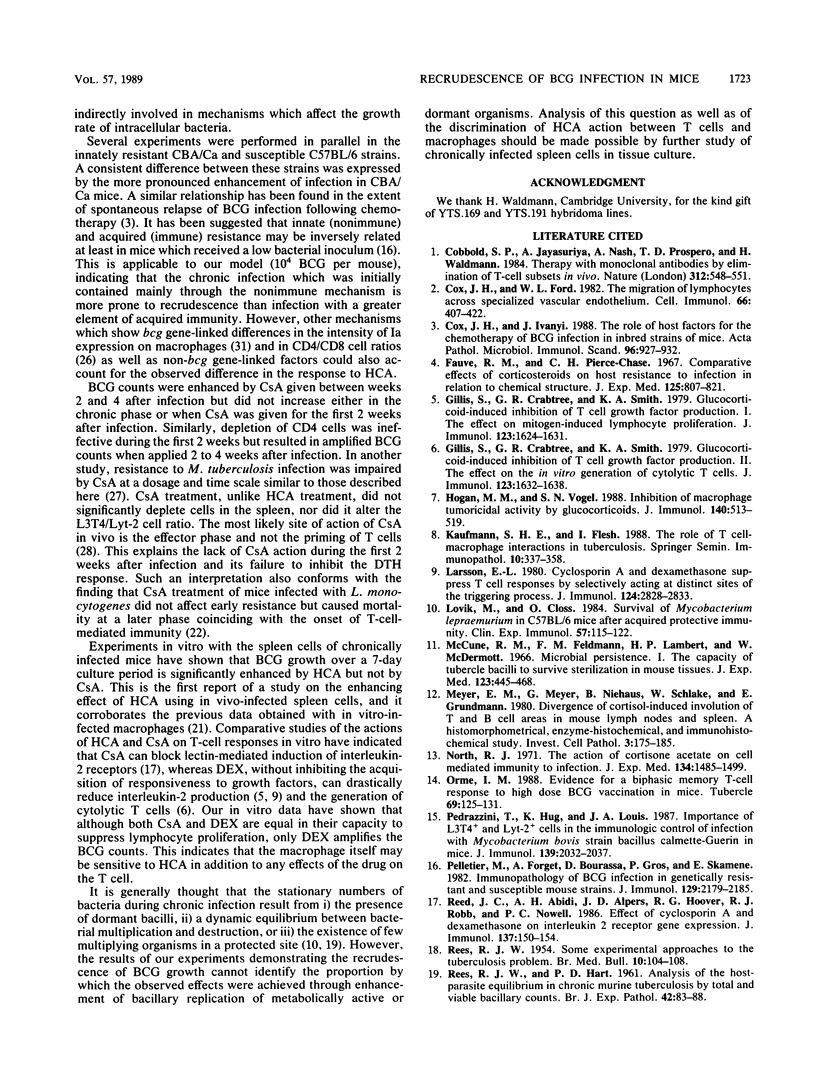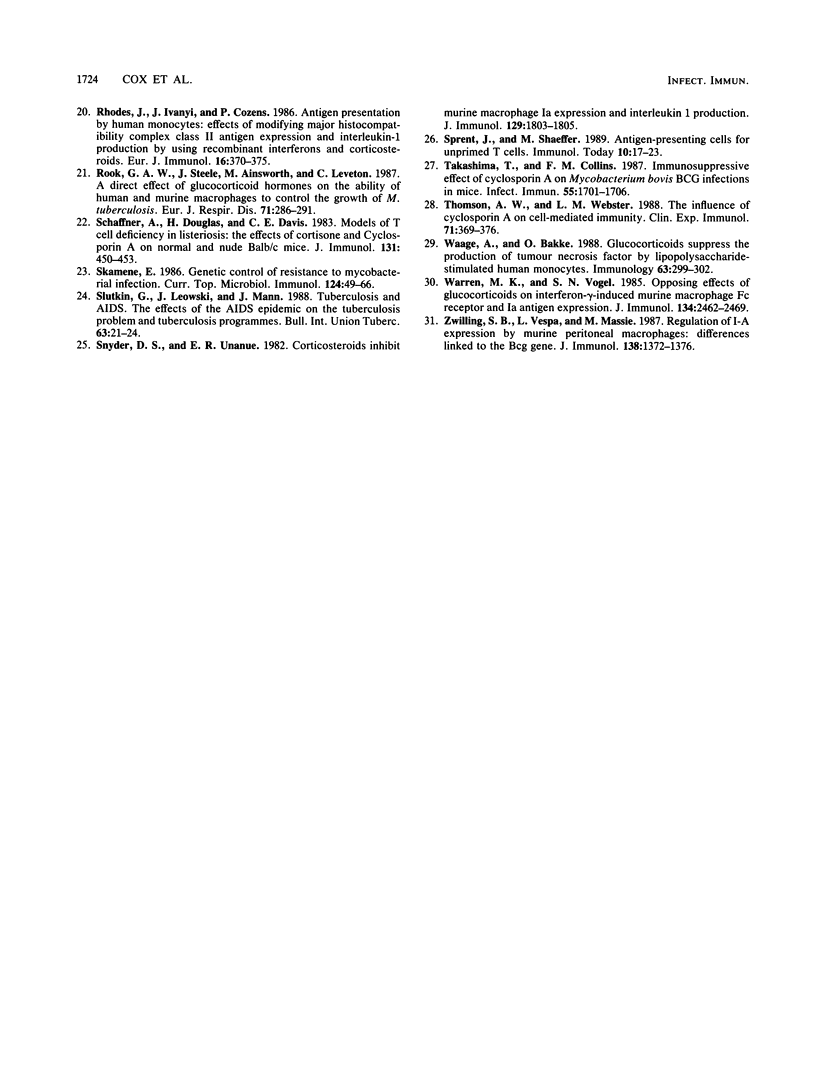Abstract
The capacity of various immunosuppressive agents to cause a recrudescence of the replication of Mycobacterium bovis BCG in the spleens of chronically infected mice was investigated. The actions of three corticosteroid preparations, cyclosporin A, and anti-T-cell subset monoclonal antibodies were compared. Treatment of mice with hydrocortisone acetate, which depressed the number of splenic lymphocytes and suppressed T-cell responses, most effectively exacerbated the stationary BCG counts, at 4 to 6 months after infection. The magnitude of reactivation was more pronounced in innately resistant CBA/Ca mice than in the susceptible C57BL/6 strain of mice. Splenic bacterial counts were also amplified by anti-L3T4 antibody when the antibody was injected at the chronic phase, whereas cyclosporin A had an effect only during the initial 6 weeks after BCG infection. Cultures of spleen cells from chronically infected mice showed a significant increase in the numbers of viable BCG recovered after 7 days of incubation in the presence of dexamethasone but not with cyclosporin A. The observed differences between the tested immunosuppressive agents indicate that the stationary bacterial counts during chronic BCG infection are maintained by discrete T-cell actions on the infected macrophages.
Full text
PDF





Selected References
These references are in PubMed. This may not be the complete list of references from this article.
- Cobbold S. P., Jayasuriya A., Nash A., Prospero T. D., Waldmann H. Therapy with monoclonal antibodies by elimination of T-cell subsets in vivo. Nature. 1984 Dec 6;312(5994):548–551. doi: 10.1038/312548a0. [DOI] [PubMed] [Google Scholar]
- Cox J. H., Ford W. L. The migration of lymphocytes across specialized vascular endothelium. IV. Prednisolone acts at several points on the recirculation pathways of lymphocytes. Cell Immunol. 1982 Jan 15;66(2):407–422. doi: 10.1016/0008-8749(82)90190-3. [DOI] [PubMed] [Google Scholar]
- Cox J. H., Ivanyi J. The role of host factors for the chemotherapy of BCG infection in inbred strains of mice. APMIS. 1988 Oct;96(10):927–932. doi: 10.1111/j.1699-0463.1988.tb00964.x. [DOI] [PubMed] [Google Scholar]
- Fauve R. M., Pierce-Chase C. H. Comparative effects of corticosteroids on host resistance to infection in relation to chemical structure. J Exp Med. 1967 May 1;125(5):807–821. doi: 10.1084/jem.125.5.807. [DOI] [PMC free article] [PubMed] [Google Scholar]
- Gillis S., Crabtree G. R., Smith K. A. Glucocorticoid-induced inhibition of T cell growth factor production. I. The effect on mitogen-induced lymphocyte proliferation. J Immunol. 1979 Oct;123(4):1624–1631. [PubMed] [Google Scholar]
- Gillis S., Crabtree G. R., Smith K. A. Glucocorticoid-induced inhibition of T cell growth factor production. II. The effect on the in vitro generation of cytolytic T cells. J Immunol. 1979 Oct;123(4):1632–1638. [PubMed] [Google Scholar]
- Hogan M. M., Vogel S. N. Inhibition of macrophage tumoricidal activity by glucocorticoids. J Immunol. 1988 Jan 15;140(2):513–519. [PubMed] [Google Scholar]
- Kaufmann S. H., Flesch I. E. The role of T cell--macrophage interactions in tuberculosis. Springer Semin Immunopathol. 1988;10(4):337–358. doi: 10.1007/BF02053845. [DOI] [PubMed] [Google Scholar]
- Larsson E. L. Cyclosporin A and dexamethasone suppress T cell responses by selectively acting at distinct sites of the triggering process. J Immunol. 1980 Jun;124(6):2828–2833. [PubMed] [Google Scholar]
- Løvik M., Closs O. Survival of Mycobacterium lepraemurium in C57BL mice after acquired protective immunity. Clin Exp Immunol. 1984 Jul;57(1):115–122. [PMC free article] [PubMed] [Google Scholar]
- McCune R. M., Feldmann F. M., Lambert H. P., McDermott W. Microbial persistence. I. The capacity of tubercle bacilli to survive sterilization in mouse tissues. J Exp Med. 1966 Mar 1;123(3):445–468. doi: 10.1084/jem.123.3.445. [DOI] [PMC free article] [PubMed] [Google Scholar]
- Meyer E. M., Meyer G., Niehaus B., Schlake W., Grundmann E. Divergence of cortisol-induced involution of T and B cell areas in mouse lymph nodes and spleen. A histomorphometrical, enzyme-histochemical, and immunohistochemical study. Invest Cell Pathol. 1980 Apr-Jun;3(2):175–185. [PubMed] [Google Scholar]
- North R. J. The action of cortisone acetate on cell-mediated immunity to infection. Suppression of host cell proliferation and alteration of cellular composition of infective foci. J Exp Med. 1971 Dec 1;134(6):1485–1500. doi: 10.1084/jem.134.6.1485. [DOI] [PMC free article] [PubMed] [Google Scholar]
- Orme I. M. Evidence for a biphasic memory T-cell response to high dose BCG vaccination in mice. Tubercle. 1988 Jun;69(2):125–131. doi: 10.1016/0041-3879(88)90075-x. [DOI] [PubMed] [Google Scholar]
- Pedrazzini T., Hug K., Louis J. A. Importance of L3T4+ and Lyt-2+ cells in the immunologic control of infection with Mycobacterium bovis strain bacillus Calmette-Guérin in mice. Assessment by elimination of T cell subsets in vivo. J Immunol. 1987 Sep 15;139(6):2032–2037. [PubMed] [Google Scholar]
- Pelletier M., Forget A., Bourassa D., Gros P., Skamene E. Immunopathology of BCG infection in genetically resistant and susceptible mouse strains. J Immunol. 1982 Nov;129(5):2179–2185. [PubMed] [Google Scholar]
- REES R. J., HART P. D. Analysis of the host-parasite equilibrium in chronic murine tuberculosis by total and viable bacillary counts. Br J Exp Pathol. 1961 Feb;42:83–88. [PMC free article] [PubMed] [Google Scholar]
- REES R. J. Some experimental approaches to the tuberculosis problem. Br Med Bull. 1954;10(2):104–108. [PubMed] [Google Scholar]
- Reed J. C., Abidi A. H., Alpers J. D., Hoover R. G., Robb R. J., Nowell P. C. Effect of cyclosporin A and dexamethasone on interleukin 2 receptor gene expression. J Immunol. 1986 Jul 1;137(1):150–154. [PubMed] [Google Scholar]
- Rhodes J., Ivanyi J., Cozens P. Antigen presentation by human monocytes: effects of modifying major histocompatibility complex class II antigen expression and interleukin 1 production by using recombinant interferons and corticosteroids. Eur J Immunol. 1986 Apr;16(4):370–375. doi: 10.1002/eji.1830160410. [DOI] [PubMed] [Google Scholar]
- Rook G. A., Steele J., Ainsworth M., Leveton C. A direct effect of glucocorticoid hormones on the ability of human and murine macrophages to control the growth of M. tuberculosis. Eur J Respir Dis. 1987 Oct;71(4):286–291. [PubMed] [Google Scholar]
- Schaffner A., Douglas H., Davis C. E. Models of T cell deficiency in listeriosis: the effects of cortisone and cyclosporin A on normal and nude BALB/c mice. J Immunol. 1983 Jul;131(1):450–453. [PubMed] [Google Scholar]
- Skamene E. Genetic control of resistance to mycobacterial infection. Curr Top Microbiol Immunol. 1986;124:49–66. doi: 10.1007/978-3-642-70986-9_4. [DOI] [PubMed] [Google Scholar]
- Slutkin G., Leowski J., Mann J. The effects of the AIDS epidemic on the tuberculosis problem and tuberculosis programmes. Bull Int Union Tuberc Lung Dis. 1988 Jun;63(2):21–24. [PubMed] [Google Scholar]
- Snyder D. S., Unanue E. R. Corticosteroids inhibit murine macrophage Ia expression and interleukin 1 production. J Immunol. 1982 Nov;129(5):1803–1805. [PubMed] [Google Scholar]
- Sprent J., Schaefer M. Antigen-presenting cells for unprimed T cells. Immunol Today. 1989 Jan;10(1):17–23. doi: 10.1016/0167-5699(89)90060-1. [DOI] [PubMed] [Google Scholar]
- Takashima T., Collins F. M. Immunosuppressive effect of cyclosporin A on Mycobacterium bovis BCG infections in mice. Infect Immun. 1987 Jul;55(7):1701–1706. doi: 10.1128/iai.55.7.1701-1706.1987. [DOI] [PMC free article] [PubMed] [Google Scholar]
- Thomson A. W., Webster L. M. The influence of cyclosporin A on cell-mediated immunity. Clin Exp Immunol. 1988 Mar;71(3):369–376. [PMC free article] [PubMed] [Google Scholar]
- Waage A., Bakke O. Glucocorticoids suppress the production of tumour necrosis factor by lipopolysaccharide-stimulated human monocytes. Immunology. 1988 Feb;63(2):299–302. [PMC free article] [PubMed] [Google Scholar]
- Warren M. K., Vogel S. N. Opposing effects of glucocorticoids on interferon-gamma-induced murine macrophage Fc receptor and Ia antigen expression. J Immunol. 1985 Apr;134(4):2462–2469. [PubMed] [Google Scholar]
- Zwilling B. S., Vespa L., Massie M. Regulation of I-A expression by murine peritoneal macrophages: differences linked to the Bcg gene. J Immunol. 1987 Mar 1;138(5):1372–1376. [PubMed] [Google Scholar]


